Fill blank cells with value above or 0 in Excel - step by step guide
In Excel, it's common practice to leave cells blank when their data would simply repeat the value of the cell above them. This formatting choice often results in a cleaner and more visually appealing layout. However, if you want to sort or filter the list, these blank cells can become problematic. In such instances, you need to populate the blanks with the values from the cells above as demonstrated in the screenshot below.
In this guide, we will focus on how to fill blank cells either with the value in the cell directly above or with 0 or any other specific value. This can be incredibly useful for handling data sets that contain empty cells, ensuring that calculations and visualizations are accurate and meaningful.
 |  |
Fill blank cells with value above
In this section, we will introduce four easy tricks for filling blank cells with value above in Excel.
- Go To Special: Native to Excel, but multiple steps required, need to convert the final formulas to values.
- Kutools for Excel: Takes only 3 clicks, easy and quickly. But requires download and installation.
- VBA code: Requires knowledge of VBA programming, possibility of bugs or errors if not coded properly.
- Power Query: Has a steeper learning curve, applicable to Excel 2016 and later versions.
Using Go To Special feature to fill blank cells with value above
With this method, you should apply the Go To Special feature to select all blank cells in the data range, then enter a very simple formula into an empty cell and then press the Ctrl + Enter keys to fill the selected blank cells with value above. Here are the steps.
Step 1: Select the blank cells
- Select the range of cells where you want to fill the blanks with value above.
- Then, click "Home" > "Find & Select" > "Go To Special", see screenshot:
 Tips: You can also press F5 key to open the Go To dialog box, and then click Special button in the Go To window to display the Go To Special dialog box.
Tips: You can also press F5 key to open the Go To dialog box, and then click Special button in the Go To window to display the Go To Special dialog box. - In the "Go To Special" dialog box, choose the "Blanks" option and click OK.
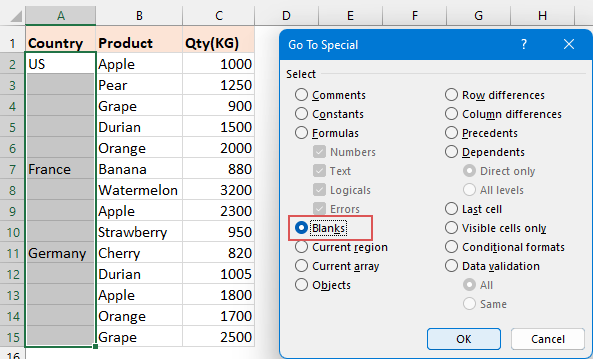
- Now all blank cells within the range are selected at once.
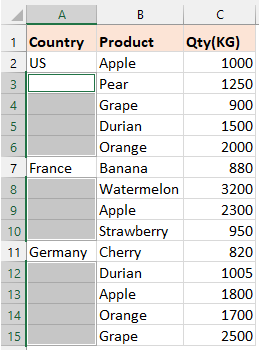
Step2: Input formula
With the blank cells still selected, type the equals sign (=) directly. The equal sign will appear in one of the selected blank cells, such as A3 in this case. Now reference the cell above it by clicking on A2. 
Step 3: Press Ctrl + Enter keys to fill all the selected blank cells
Now, press Ctrl + Enter keys together to copy the formula to all other selected cells. And all the selected blank cells are filled with the value from the cell directly above them. See screenshot:
Step 4: Convert formulas to values
Now, the selected blank cells are formulas, you should convert these formulas to values. Please select the data range which contains the formulas, then press Ctrl + C to copy the data list, and then right click the copied range, and select "Values" from the "Paste options" section, see screenshot:
And now, the formulas are converted to static values, you can do any other operations as you need.
Using Kutools for Excel
If you are looking for a quick and easy solution, Kutools for Excel’s "Fill Blank Cells" feature could be an excellent tool for you. With this powerful feature, you can quickly finish the following operations:
- Fill blank cells with value above, down, left or right
- Fill blank cells with series of linear values
- Fill blank cells with a specific value
After downloading and installing Kutools for Excel, please do as this:
To fill blank cells with value above, please select the data range that you want to fill blank cells, and then click "Kutools" > "Insert" > "Fill Blank Cells", then specify the operations in the "Fill Blank Cells" dialog box:
- Select "Based on values" option from the "Fill with" section.
- Choose "Down" in the "Options" section. (You can also select the Up, Right or Left to fill the blank cells with value down, left or right as you need)
- Click OK to apply this feature.
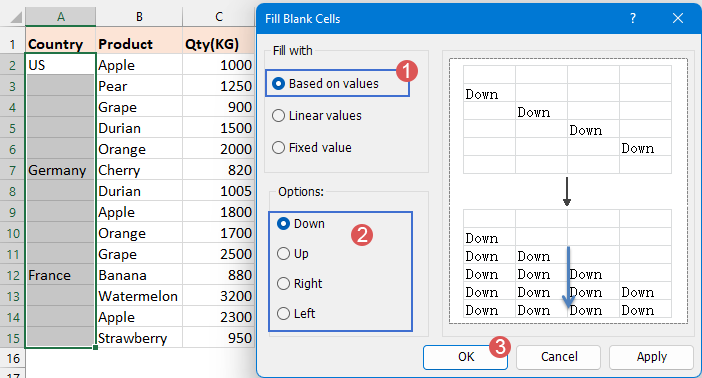
Result:
Now, all blank cells are populated with the value above as following screenshot shown:
Using VBA code to fill blank cells with value above
If you are familiar with VBA code, here, we will provide a code for filling blank cells with value above. Please do with the following steps:
Step 1:Open the VBA module editor and copy the code
- Hold down the "ALT + F11" keys in Excel, and it opens the "Microsoft Visual Basic for Applications" window.
- Click "Insert" > "Module", and paste the following code in the Module Window.
VBA code: Insert blank cells with value aboveSub FillBlankCellsWithValueAbove() 'Updateby Extendoffice Dim WorkRng As Range Dim cell As Range On Error Resume Next xTitleId = "KutoolsforExcel" Set WorkRng = Application.Selection Set WorkRng = Application.InputBox("Range", xTitleId, WorkRng.Address, Type:=8) On Error GoTo 0 If WorkRng Is Nothing Then MsgBox "No valid range selected.", vbExclamation, "Error" Exit Sub End If For Each cell In WorkRng If IsEmpty(cell) Then cell.Value = cell.Offset(-1, 0).Value End If Next cell End Sub
Step 2: Execute the code
After pasting this code, please press F5 key to run this code. In the prompt box, select the data range where you want to fill blank cells with value above. And then, click OK. 
Result:
Now, all blank cells are populated with the value above as following screenshot shown: 
Using Power Query to fill blank cells value above
If you are using Excel 2016 and later version, Excel provides a powerful feature – Power Query, which can help to populate each block of empty cells in the column using the value from the cell above them immediately. Here are the steps to do it:
Step 1: Get the data into Power Query
- Select the data range that you want to use, then click "Data" > "From Table", see screenshot:
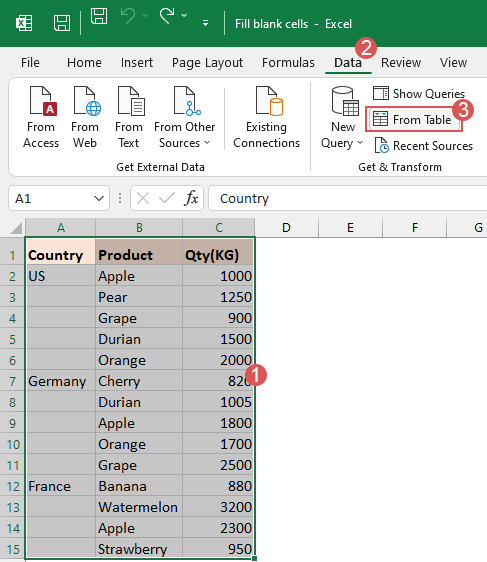 Tips: In Excel 2019 and Office 365, click "Data" > "From Table/Range".
Tips: In Excel 2019 and Office 365, click "Data" > "From Table/Range". - In the popped-out "Create Table" dialog box, click OK button to create a table, see screenshot:
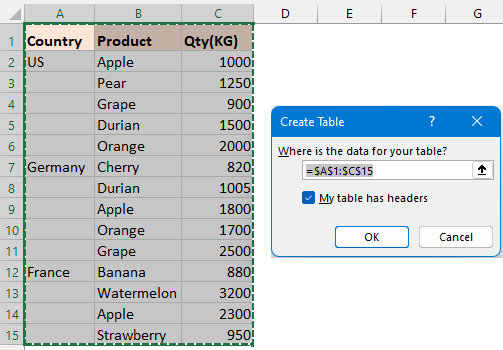
- Now, the "Power Query Editor" window is displayed with the data, see screenshot:

Step 2: In the Power Query Editor window, specify the operations
- Click the header of the columns that you want to fill the blank cells with value above. And then, right click the selected header, choose "Fill" > "Down", see screenshot:
 Tips: To fill blank cells in multiple columns, hold down the Ctrl or Shift key and click the column headers to select non-adjacent or adjacent columns, then right click any selected column, and then select "Fill" > "Down" as previously described.
Tips: To fill blank cells in multiple columns, hold down the Ctrl or Shift key and click the column headers to select non-adjacent or adjacent columns, then right click any selected column, and then select "Fill" > "Down" as previously described. - Now, all the blank cells in the selected column are filled with the value from the cell directly above them, see screenshot:

Step 3: Output the Power Query to an Excel table
- Then, you should output the data into your worksheet. Please click "Home" > "Close & Load" > "Close & Load / Close & Load To", (here, I will click "Close & Load"), see screenshot:
 Tips: Click Close & Load will output the data to a new worksheet; Click Close & Load To option, the data will be output to a new sheet or current sheet you need.
Tips: Click Close & Load will output the data to a new worksheet; Click Close & Load To option, the data will be output to a new sheet or current sheet you need. - And then, the data will be loaded to a new worksheet, see screenshot:
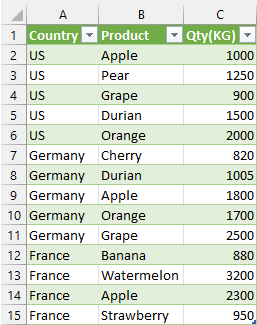
Fill blank cells with 0 or specific value
If you need to fill blank cells with 0 or any other specific value, here, I will talk about two quick methods.
Using Go To Special feature to fill blank cells with 0 or specific value
Step 1: Select the blank cells
- Select the range of cells where you want to fill the blanks with 0 or specific value.
- Then, click "Home" > "Find & Select" > "Go To Special", see screenshot:
 Tips: You can also press F5 key to open the "Go To" dialog box, and then click "Special" button in the "Go To" window to display the "Go To Special" dialog box.
Tips: You can also press F5 key to open the "Go To" dialog box, and then click "Special" button in the "Go To" window to display the "Go To Special" dialog box. - In the "Go To Special" dialog box, choose the "Blanks" option and click OK.

- Now all blank cells within the range are selected at once.
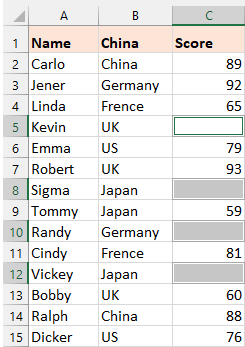
Step2: Input 0 or specific value
With the blank cells still selected, type 0 or other specific value you need directly, see screenshot: 
Step 3: Press Ctrl + Enter keys to fill all the selected blank cells
Now, press Ctrl + Enter keys together to fill the selected blank cells with the value you typed, see screenshot:

Don't let blanks slow you down, Let Kutools for Excel fill them up!
Empty cells disrupting your flow? Transform your Excel journey with Kutools. Filling all types of blank cells, perfectly meeting your needs. No blanks, just brilliance! Download Kutools for Excel Now!
Fill blank cells with 0 or any other specific value

Don't let blanks slow you down, Let Kutools for Excel fill them up!
Empty cells disrupting your flow? Transform your Excel journey with Kutools. Filling all types of blank cells, perfectly meeting your needs. No blanks, just brilliance! Download Kutools for Excel Now!
Fill blank cells with a series of linear values

Don't let blanks slow you down, Let Kutools for Excel fill them up!
Empty cells disrupting your flow? Transform your Excel journey with Kutools. Filling all types of blank cells, perfectly meeting your needs. No blanks, just brilliance! Download Kutools for Excel Now!
Fill blank cells with value above/down/left/right
Using Find and Replace feature to fill blank cells with 0 or specific value
Excel’s Find and Replace feature also can help to fill blank cells with 0 or any other specific value, please do with the following steps:
Step 1: Select the data range and enable the Find and Replace feature
- Select the data range where you want to fill blank cells with a specific value.
- Then, click "Home" > "Find & Select" > "Replace" (you can also press "Ctrl + H" to open the "Find and Replace" dialog box), see screenshot:
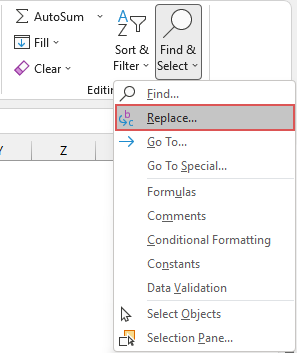
Step 2: Specify the operations in the Find and Replace dialog box
- In the "Find and Replace" dialog box, leave the "Find what" text box blank, then type the specific value into the "Replace with" text box. And then, click "Replace All" button. See screenshot:

- A prompt box is popped out to remind you how many cells are replaced with the new value. At last, click OK and close the Find and Replace dialog box.
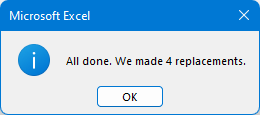
Result:
Now, the blank cells in the selected range are filled with the specific value you entered, see screenshot:
This is how you can fill blank cells with value above or a specific value. If you're interested in exploring more Excel tips and tricks, our website offers thousands of tutorials. Thank you for reading, and we look forward to providing you with more helpful information in the future!
Related Articles:
- Auto fill serial numbers and skip blanks
- If you have a list of data which contains some blank cells, now, you want to insert serial numbers for the data, but skip the blank cells as below screenshot shown. In this article, I will introduce a formula for solving this task in Excel.
- Fill blank cells with linear values
- Do you need to fill blank cells with linear values in selections? This article is going to introduce some tips about how to fill blank cells with linear values in selections quickly.
- Fill blank cells with dash
- Supposing you have a range of data which contains some blank cells, and now, you want to fill each of these blank cells with the dash symbol as following screenshots shown, do you have any good ideas to fill the blank cells with dashes at once in Excel?
Best Office Productivity Tools
Supercharge Your Excel Skills with Kutools for Excel, and Experience Efficiency Like Never Before. Kutools for Excel Offers Over 300 Advanced Features to Boost Productivity and Save Time. Click Here to Get The Feature You Need The Most...
Office Tab Brings Tabbed interface to Office, and Make Your Work Much Easier
- Enable tabbed editing and reading in Word, Excel, PowerPoint, Publisher, Access, Visio and Project.
- Open and create multiple documents in new tabs of the same window, rather than in new windows.
- Increases your productivity by 50%, and reduces hundreds of mouse clicks for you every day!
All Kutools add-ins. One installer
Kutools for Office suite bundles add-ins for Excel, Word, Outlook & PowerPoint plus Office Tab Pro, which is ideal for teams working across Office apps.
- All-in-one suite — Excel, Word, Outlook & PowerPoint add-ins + Office Tab Pro
- One installer, one license — set up in minutes (MSI-ready)
- Works better together — streamlined productivity across Office apps
- 30-day full-featured trial — no registration, no credit card
- Best value — save vs buying individual add-in
















